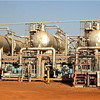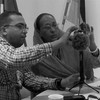Is there a third way?

The Comprehensive Peace Agreement has established a federal state combining a federal union and a confederation in a mixed way. This has been achieved as a result of the conciliation of views of the negotiating parties.
With the date of the self-determining Southern Sudan referendum (January 2011) quickly looming, the political scene in Sudan has entertained a new idea as a third option, and a possible common territory between those dreaming of unity and realists who assert that secession is the more likely outcome.
The idea of confederation was put forward by retired Brigadier Abdelazizi Khalid, candidate of the Sudanese National Alliance Party for the presidential elections of April 2010, during the party\'s general congress on May 2009.
The same idea was put forward by both Al Sadig Al Mahdi, President of Umma National Party (UNP) and its candidate for the presidential elections, and Mubarak Al-Fadil, President of Umma Party Reform and Renewal and its candidate for the presidential elections in 2009 during the meeting held between the political forces and the Sudan People\'s Liberation Movement (SPLM) in Juba.
The idea was introduced on the basis that the confederation option would ensure independence of the South in terms of foreign policy, security and defence, while maintaining the popular and economic ties with the North in terms of a single currency and open borders which allow the free movement of people and goods, and ensure the holding of both citizenships, in addition to holding a referendum after ten years to confirm unity or maintain the status quo.
Following the declaration of election results, calls to adopt the confederation option were renewed and a number of newspapers reported that the National Congress proposed the confederation option to SPLM.
However, Dr. Luka Biong, a SPLM prominent leader and Minister of the Cabinet Affairs, said during a seminar that the people of Southern Sudan had only two options, namely unity, which meant maintaining the status quo in terms of apportioning the Southerners\' power and wealth, or secession, which meant the Southerners\' choosing to form their own independent state.
This was interpreted at the time that SPLM was sending a message suggesting that a confederation was not on the table, at least at this stage, and that the options were either unity or secession.
Middle ground
During the period that preceded SudanÕs declaration of independence on 1 January 1956, the key demand of Southern Sudanese MPs in the first elected legislative assembly, in return for unanimously sanctioning the declaration of independence, was to recognise the federal claims of Southern Sudan. However, after independence, politicians of the North refused the South\'s demands for many reasons, the most important of which was that this would be the first step for separating Southern Sudan from the North.
During the roundtable conference held in Khartoum with the participation of the political powers from the North and the South, after the October 1964 Revolution, Southern politicians put forward new options in addition to the federal claim; the right of self-determination and the secession of Southern Sudan from the North.
The Addis Ababa Agreement signed in 1972 between the Sudanese Government and the Anya Nya Movement in the South led by General Joseph Lagu was designed to grant Southern Sudan autonomy and an elected government. However, this agreement did not last long given that the South had limited legislative and executive jurisdiction. The Agreement soon diminished as a result of the political struggle between the various political groups, and eventually ended by late President Jaafar Nimeiri\'s decision to divide Southern Sudan into three regions, which was considered a violation of the Agreement, and led to another civil war and the rise of SPLM and SPLA led by Colonel Dr. John Garang de Mabior.
Different currents inside SPLM
On its part, SPLM has several currents that are at odds with each other over the issue of federalism. The major transformation inside SPLM was Al Nasser\'s breakaway led by Dr. Riak Mashar and Dr. Lam Akoul, who called for changing SPLM mission and restricting it to granting the people of Southern Sudan the right of self-determination, which prompted the main faction led by Dr. John Garang to accept this demand while trying to distinguish his position from that of Al Nasser Group.
During the first congress of SPLM held in Chukudum on 2 April 1994, Dr. John Garang put forward his vision for the future political models of Sudan; a Sudan transforming to democracy, a consensus Sudan, a unified Arab Islamic Sudan, a secular black African Sudan and complete separation.
These models were put forward again during the seminar held in the United States in 2002, in which Dr. John Garang underlined that the consensus Sudan model was a confederation, i.e. a transitional situation that includes transitional arrangements in which two entities coexist (old Sudan and new Sudan), according to which old Sudan exercises its authority over the parts that do not have armed resistance, while the other parts where there is a civil war become under SPLM authority.
Dr. John Garang explained that each state would have its own laws and security arrangements, while the controversial issues such as the application of Sharia law and other similar matters would be addressed by each state separately according to its own constitution. He underlined that a state might not force the other state to do something against its will since the security arrangements would be separate. He also added that the general principles agreed upon by the two states within the confederation and the cooperation to achieve mutual benefit would enable both to establish a true unity based on mutual benefit not compulsion or submission which paved the way to total separation as a result of the sole interests of one of the two states.
This model was presented by SPLM during the Abuja 2 talks, and it presented a draft confederal constitution to the Organisation of African Unity (which has later became the African Union) to set out its vision designed to end the civil war in the South. This vision was previously presented during the peace negotiations sponsored by IGAD after the approval of the Sudanese Government to negotiate according to its principles in 1997 over the form of the confederation. SPLM also presented its vision in detail in its reply to the mediators\' proposal in June 2002.
Mentioning of confederation in agreements
Confederation as one of the Southerners\' options included in the self-determination referendum was mentioned for the first time in Chukudum Agreement signed between SPLM and UNP on 2 April 1994. It was also mentioned in the decision issued by National Democratic Alliance (NDA) during the Asmara 1995 Conference of Fundamental Issues about the right of self-determination. Article 13 of that decision stipulates that all NDA members should take a unified stand vis-a-vis the two options of the Southern Sudan referendum; unity as a federation or a confederaion; and independence.
One Sudan with two systems
After George. W. Bush won the presidential elections in 2000, a workshop was held at Washington based Center for Strategic and International Studies (CSIS) in February 2001 with the participation of 71 persons, including a number of Sudanese officials, on the U.S. policy to end the civil war in Sudan and to develop a U.S. strategy toward Sudan. This workshop was chaired by Francis Deng and Stephen Morrison.
One of the six main recommendations issued by the workshop calls for the need of the United States to form a new international group that comprises Sudan\'s neighbouring countries, in addition to other countries, to end the civil war in Sudan through a declaration of principles that support the right of self-determination of the people of Southern Sudan but also give priority to national unity by the establishment of a secular democratic state which secure political equality, separation of religion and state, equitable distribution of wealth among regions, and the possibility of establishing one Sudan with two systems, which indirectly implies a confederation.
Implementation on the ground
The political calls launched recently by a number of political leaders to put confederation on the table as a third option for the citizens of Southern Sudan in the next referendum is in fact a consolidation of the choice of unity as a result of loosely applying the confederation model at the present time rather than being a new choice for applying a different model.
The Comprehensive Peace Agreement laid the foundation for a federal state that was a combination of a federal union and a real confederation, which was the result of the conciliation of the views of the agreement parties; the Sudanese government which put forward the federal state proposal, and SPLM which retained its own concept of confederation.
The federal aspect is evident in the existence of a central high constitution that governs all the state\'s institutions, levels and central authorities (legislative, executive and judicial powers). In this system, the Sudanese states have some of internal sovereignty through their own legislative, executive and judicial powers.
The central legislative level on the other hand consists of the two following assemblies:
1. National assembly: in charge of legislation in matters that concern the state as a whole, such as foreign relations, national defence, customs affairs, communication and immigration, in addition to taking part in organising key issues with state-level parliaments through laying down a number of general rules that should be adhered to by these parliaments upon formulating their own legislations.
2. States\' assembly: comprises two members from each state, regardless of its area or population, and is in charge of safeguarding the interests of states.
A real union or a confederation on the other hand consists of two entities; the North and the South and they are different in terms of their government institutions. Southern Sudan has two levels of government; a regional level that consists of legislative, executive and judicial authorities and a state level where the regional government of Southern Sudan is considered as the link between the national level and the states of Southern Sudan.
The aspects of unity in the Comprehensive Peace Agreement are represented in the higher constitution (national constitution), the institutions on national level and its authorities (legislative, executive and judicial) and the relationship between the three levels (national, southern and state), which is coordinating relationship based on consent. The president of the republic deals directly with the state governors of the North but can deal with the governors of the Southern states via the first vice-president only, who is the head of the government of Southern Sudan.
Southern Sudan has a traditional transactions-based banking system, its own armed forces and the right of establishing representative offices overseas (these offices do not have the capacity of embassies) that function in coordination with the Sudanese embassies in the related countries. The South has also the right to have access to foreign loans provided that the Southern government are committed to settle such loans.
The North does not have a regional government level since it consists of states that are directly linked to the national level. The banking system in the North is based on Islamic transactions, and no state in the North is entitled to establish representative offices overseas or receive foreign loans without the involvement of the federal government.
So, it is important to underline the fact that raising the issue of confederation aims to bring the views of unionists and separatists closer, which is consistent with the belief in the inevitability of \"the existence of a middle ground that brings all different positions together\".




